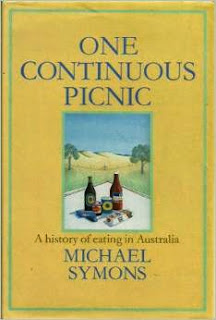The first book I have read in the new year is One Continuous Picnic: A History of Eating in Australia by Michael Symons (1982). I didn't pick it for any reasons of significance -- it's been on my shelf for a while. I read the original edition, though it appears to have been updated in 2007.
Symons covers an incredible amount of material in this book, beginning with the arrival of the first convict ships in January, 1788, continuing with the early settlers, the development of cities in the 19th century, and the impact of the two World Wars on Australian food and agriculture. His chapters on the 1950s through 1970s show how trends familiar from American food history also affected Australian cuisine. Twentieth-century industrialization and mass production of food is one of Symons' recurring themes. I found it interesting how much this process followed the lead of European and especially American inventors and business developments.
I had been aware that American bases in northern Australia during World War II were a significant force for change. I was very interested in details of how the American military imported food processing plants (in particular a Coca Cola bottling plant) and how they changed Australian food processing and agriculture. The Yanks made quite an impact with their demands for beef and pork instead of the Australian choice of mutton and with their consumption of more fruit and vegetables.
The Pavlova, a meringue-based cake with fruit, is often claimed as a truly original Australian contribution to world cuisine from around 1929. Symons documents that New Zealand's counter-claims to have invented the Pavlova have merit. A winner of a baking contest in an Australian women's magazine was from New Zealand: she submitted a popular New Zealand recipe for a nearly identical cake. The Australian chef who "invented" the Pavlova soon after the contest was very likely to have read the magazine. Although the name Pavlova in New Zealand referred to a slightly different meringue cake, Symons concedes that Australia can't claim sole creation of the dish.
Symons seems amazed at how few native Australian plants or food products became mainstream or were adopted outside Australia: basically, the macadamia nut is the only native plant to go global -- and it was first shipped worldwide from plantations in Hawaii. Early versions of the Pavlova used passionfruit -- more recent versions use strawberries or other fruit. While the passionfruit was extremely popular and grown widely in Australia by the 19th century according to Symons, it was a South American import.
Maybe the updated version of the book reflects the recent popularity of raising emus for eggs and meat in the US, though I don't think it's a very high-impact trend!
I had heard of this book long ago, and I'm glad I have finally read it!


1 comment:
This sounds fascinating, Mae. You always find the most intriguing books!
Post a Comment